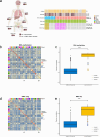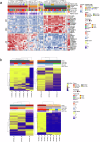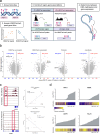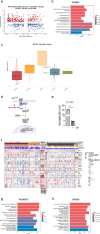Intraindividual epigenetic heterogeneity underlying phenotypic subtypes of advanced prostate cancer
- PMID: 40593552
- PMCID: PMC12219151
- DOI: 10.1038/s41467-025-60654-z
Intraindividual epigenetic heterogeneity underlying phenotypic subtypes of advanced prostate cancer
Abstract
Castration-resistant prostate cancer is a heterogeneous disease with variable phenotypes commonly observed in later stages of the disease. These include cases that retain expression of luminal markers and those that lose hormone dependence and acquire neuroendocrine features. While there are distinct transcriptomic and epigenomic differences between castration-resistant adenocarcinoma and neuroendocrine prostate cancer, the extent of overlap and degree of diversity across tumor metastases in individual patients has not been fully characterized. Here we perform combined DNA methylation, RNA-sequencing, H3K27ac, and H3K27me3 profiling across metastatic lesions from patients with CRPC/NEPC. Integrative analyses identify DNA methylation-driven gene links based on location (H3K27ac, H3K27me3, promoters, gene bodies) pointing to mechanisms underlying dysregulation of genes involved in tumor lineage (ASCL1, AR) and therapeutic targets (PSMA, DLL3, STEAP1, B7-H3). Overall, these data highlight how integration of DNA methylation with RNA-sequencing and histone marks can inform intraindividual epigenetic heterogeneity and identify putative mechanisms driving transcriptional reprogramming in castration-resistant prostate cancer.
© 2025. The Author(s).
Conflict of interest statement
Competing interests: T.K.C reports institutional and/or personal, paid and/or unpaid support for research, advisory boards, consultancy, and/or honoraria past 10 years, ongoing or not, from Alkermes, Arcus Bio, AstraZeneca, Aravive, Aveo, Bayer, Bristol Myers-Squibb, Bicycle Therapeutics, Calithera, Circle Pharma, Deciphera Pharmaceuticals, Eisai, EMD Serono, Exelixis, GlaxoSmithKline, Gilead, HiberCell, IQVA, Infinity, Institut Servier, Ipsen, Jansen, Kanaph, Lilly, Merck, Nikang, Neomorph, Nuscan/PrecedeBio, Novartis, Oncohost, Pfizer, Roche, Sanofi/Aventis, Scholar Rock, Surface Oncology, Takeda, Tempest, Up-To-Date, CME and non-CME events (Mashup Media Peerview, OncLive, MJH, CCO), for work unrelated to the present study. A.K.T. reports institutional research funding from Novartis for work unrelated to the present study. D.E. reports institutional research funding and honoraria from Bayer, Bristol-Myers Squibb, Cardiff Oncology, MiNK Therapeutics, Novartis, Puma Biotechnology, Sanofi, Nimbus Therapeutics, Foundation Medicine, for work unrelated to the present study. S.S. has served as a consultant advisor for Bristol Myers Squibb, Merck Sharp and Dohme, AstraZeneca, Novartis, Janssen and Merck Serono (funds go to the institution) and received research grants for investigator-initiated trials from Novartis, Genentech, Amgen, AstraZeneca, Merck Serono, Merck Sharp and Dohme, Pfizer and Senwha (funds go to the institution) for work unrelated to the present study. H.B. has served as consultant/advisory board member for Astra Zeneca, Merck, Pfizer, Amgen, Novartis, Bayer, Daiichi Sankyo, and has received research funding (to institution) from Janssen, Bristol Myers Squibb, Circle Pharma, Daiichi Sankyo, Novartis for work unrelated to the present study. The remaining authors declare no competing interests.
Figures




References
MeSH terms
Substances
Grants and funding
- R37CA241486-01A1/U.S. Department of Health & Human Services | NIH | National Cancer Institute (NCI)
- HT94252310407/U.S. Department of Defense (United States Department of Defense)
- R37 CA241486/CA/NCI NIH HHS/United States
- P50 CA211024/CA/NCI NIH HHS/United States
- P30 CA006516/CA/NCI NIH HHS/United States
LinkOut - more resources
Full Text Sources
Medical
Research Materials
Miscellaneous

